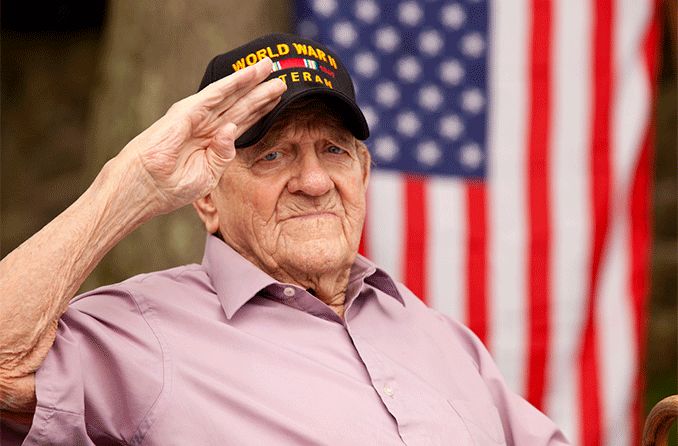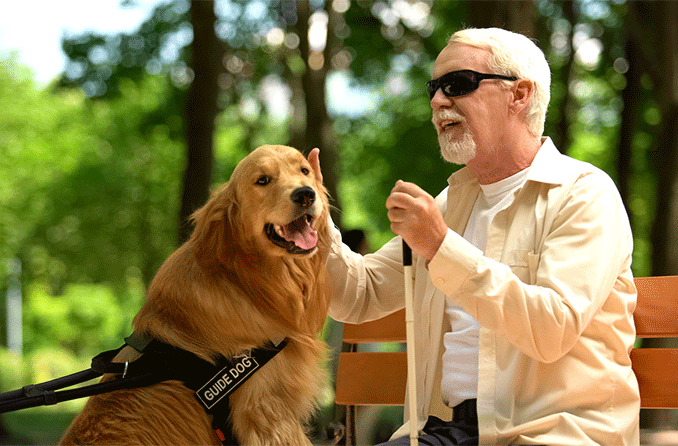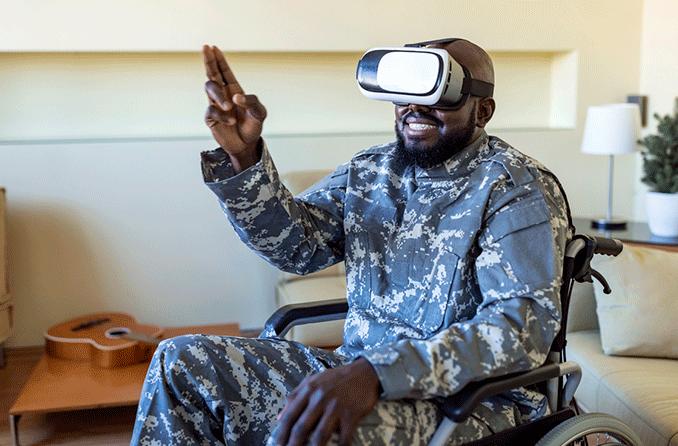Resources for Visually Impaired Veterans
- Blind Rehabilitation Centers
- Golf for vision-impaired veterans
- Intermediate and Advanced Low Vision Clinics
- Vision Impairment Services in Outpatient Rehabilitation (VISOR) programs
- Advanced Ambulatory Low Vision Clinics
- Visual Impairment Centers to Optimize Remaining Sight (VICTORS) program
- Blind Rehabilitation Outpatient Specialist (BROS) program
- Veterans Innovative Sight in Optometry Nexus (VISION) project
- Ocular trauma centers
- Guide dogs
- Research programs
- Technology for veterans with vision problems
- Organizations that help veterans with vision problems

More than 130,000 U.S. military veterans are legally blind, and 1.5 million veterans have low vision. Fortunately, a variety of resources are available for visually impaired veterans.
Among older veterans, major causes of vision loss include age-related macular degeneration, glaucoma, cataracts, stroke and diabetic retinopathy. Some veterans who served in Iraq and Afghanistan experience blast-related brain injuries that can lead to blurred vision, double vision, sensitivity to light and difficulty reading. Nearly two-thirds of servicemembers with traumatic brain injuries may suffer vision problems, while eye injuries account for nearly 15% of combat casualties.
A study published in 2019 in the journal Military Medicine found that from 2000 to 2017, members of the U.S. armed services suffered an annual average of 15,681 eye injuries with 304 hospital stays. In addition, a yearly average of 4,394 cases of traumatic brain injury not accompanied by an eye injury caused visual impairment. In 2017 dollars, the study calculated an annual cost of treatment, benefits and potential lost productivity of $2.4 billion related to these eye injuries and traumatic brain injuries.
Veterans with vision impairment caused or aggravated by active-duty service may qualify for benefits, such as tax-free monthly payments, from the U.S. Department of Veterans Affairs (VA). If their vision impairment isn’t connected to active-duty service, a veteran still may qualify for treatment or rehabilitation from a VA center or program. To schedule an eye exam, contact your nearest VA medical center.
The VA introduced a comprehensive blindness and vision rehabilitation program in 2008 with establishment of the Vision Center of Excellence, shared by the VA and the U.S. Department of Defense. The center is located at Walter Reed National Military Medical Center in Bethesda, Maryland.
What follows is a roundup of resources for veterans who are visually impaired.
Blind Rehabilitation Centers
The VA operates 13 Blind Rehabilitation Centers (BRCs). These inpatient centers help veterans adjust to their blindness, assisting with skills such as:
Mobility
Visual skills
Manual skills
Communication skills
Daily activities
Computer use
Social and recreational activities
The Blind Rehabilitation Centers are in:
Augusta, Georgia
Biloxi, Mississippi
Birmingham, Alabama
Cleveland, Ohio
Hines, Illinois
Long Beach, California
Palo Alto, California
San Juan, Puerto Rico
Tacoma, Washington
Tucson, Arizona
Waco, Texas
West Haven, Connecticut
West Palm Beach, Florida
In congressional testimony given in 2020 and 2021, Thomas Zampieri, president of the Blinded Veterans Association, worried that some Blind Rehabilitation Centers were understaffed.
The care of visually impaired veterans in rural areas is of particular concern. A study published in 2020 in the journal Eye Reports found that the incidence of vision loss was more prevalent among older veterans in rural regions in the U.S. than in urban regions in the U.S.
“The results of this study demonstrate the need for broader access to health care, including evidence-based remote or telehealth eye care screening and rehabilitation programs, for rural veterans, especially within the [VA health care] system,” the study’s authors wrote.

Golf for vision-impaired veterans
Nine of the VA’s Blind Rehabilitation Centers provide instruction in what’s known as “blind golf” to veterans with blindness or low vision.
As part of their rehabilitation, World War II veterans were introduced in the 1940s to the game of golf at Old Avon Farms in Connecticut. The Blind Rehabilitation Center in Hines, Illinois, added blind golf to its offerings in 1948. That’s the same year that the United States Blind Golf Association was founded.
Intermediate and Advanced Low Vision Clinics
Operated by the VA, the Intermediate and Advanced Low Vision Clinics are outpatient locations where veterans can receive services that go beyond what’s offered at VA eye clinics. These include eye exams, use of vision-enhancing devices and training in visual skills. Specialists at these clinics help with daily tasks such as reading, writing, cooking and managing medications.
A study published in 2020 by the journal Optometry and Vision Science showed that about one-third of veterans referred for outpatient vision rehabilitation exhibited cognitive impairment. “Future research should determine best practices to accommodate challenges associated with cognitive impairment in vision rehabilitation and to track clinically meaningful outcomes,” the study’s authors wrote.
Vision Impairment Services in Outpatient Rehabilitation (VISOR) programs
VISOR programs provide short-term rehabilitation for blindness or vision problems. They last about two weeks and include overnight accommodations for those who need lodging. VISOR participants must be able to carry out daily living activities on their own.
Aside from the variety of services provided at the Intermediate and Advanced Low Vision Clinics, VISOR offers training in communication, computer use and daily living. Skills that may be covered include typing, handwriting, telling time, managing financial records, preparing meals and arranging a wardrobe.
Advanced Ambulatory Low Vision Clinics
These 23 clinics emphasize vision skills and vision enhancement, enabling a veteran to better carry out daily activities. This includes travel and other mobility-related activities.
Visual Impairment Centers to Optimize Remaining Sight (VICTORS) program
VICTORS complements the VA’s 13 Blind Rehabilitation Centers. The outpatient program cares for veterans with significant visual impairment (20/70 to 20/200 visual acuity or worse; significant visual field loss; or both). The program features specialists in optometry, ophthalmology, social work, psychology and low vision therapy.
The three VICTORS locations are:
Lake City, Florida
Northport, New York
Palo Alto, California
Blind Rehabilitation Outpatient Specialist (BROS) program
In the BROS program, specialists teach skills to blind veterans at their own homes or at VA medical centers. A BROS instructor is well versed in at least two of these disciplines: orientation and mobility, living skills, manual skills and visual skills.
Veterans Innovative Sight in Optometry Nexus (VISION) project
The tech-enabled VISION project aims to improve access to eye care and prevent blindness. In 2017, a pilot program was underway at the White River Junction VA Medical Center in Vermont. VISION is designed to increase the time and efficiency of eye care visits.
Ocular trauma centers
The 2017 National Defense Authorization Act called for designation of four ocular trauma centers within the VA medical system. But as of March 2021, no centers had received that designation.
Guide dogs
The VA supports guide dogs that help blind and visually impaired veterans avoid obstacles. These dogs aren’t provided by the VA. Veterans who are approved for a guide dog are referred to organizations accredited by Assistance Dogs International or the International Guide Dog Federation.
“Guide dog schools continue to maintain their close partnership with blinded veterans, by providing training and dogs at virtually no cost to veterans, along with continued support services to help the teams adjust to new challenges,” according to an article published in 2010 in the journal Military Medicine. “The use of guide dogs continues to be a viable option for many of our nation’s blind veterans.”

Research programs
VA researchers at sites in Atlanta, Georgia and Iowa City, Iowa, work on projects aimed at:
Improving vision testing.
Repairing or easing vision loss due to disease or injury.
Learning more about the connection between injury and vision loss.
Increasing the independence of veterans with blindness or low vision.
Improving access to eye care for veterans living in rural areas.
Detecting disorders that potentially cause blindness, such as glaucoma and traumatic brain injury.
Offering greater access to telemedicine.
Academic researchers also are working on projects to help visually impaired veterans. For instance, researchers at Cal State Fullerton are developing a low-cost, voice-controlled robotic arm to assist visually impaired veterans with everyday tasks like opening a door or grabbing items from a refrigerator. The VA is financing this research with a nearly $200,000 grant.
At the University of Pittsburgh, Dr. Kia Washington leads a research program investigating the potential for eye transplants. The program is financed by a multimillion-dollar grant from the Department of Defense. In 2016, Washington predicted that eye transplants in humans could happen in 10 years. This innovation could benefit the many American servicemembers who suffer eye injuries during combat.
Technology for veterans with vision problems
Several inventions can help vision-impaired veterans see better:
eSight 3
In 2019, the VA made a wearable sight-enhancing device available to veterans with low vision. A Canadian company called eSight is permitted to offer its eSight 3 device via the VA through at least December 2023.
The device relies on high-resolution screens, smart algorithms and a cutting-edge camera to help a person with low vision see clearly and lead an active, independent life.
IrisVision
Also in 2019, the VA added a low vision headset from California-based IrisVision to its list of available medical devices. The headset helps people with eye conditions such as age-related macular degeneration, glaucoma, retinitis pigmentosa, diabetic retinopathy, optic nerve damage and cataracts.
MyEye
Visually impaired veterans may be eligible for OrCam’s MyEye device as well. The device, which mounts on a person’s eyeglasses, helps them read text, identify faces, pick out products while shopping and recognize barcodes. The Bluetooth-enabled device responds to hand gestures and voice commands. Israel-based OrCam makes the device.

Organizations that help veterans with vision problems
Among the organizations that help with various aspects of blindness or low vision among veterans are:
MD Support (for macular degeneration)
National Research and Training Center on Blindness and Low Vision
Aside from the VA, federal agencies or programs that assist veterans with blindness or low vision include:
READ NEXT: Veterans eye care
Vision loss. U.S. Department of Veterans Affairs. Accessed March 2021.
Blind Veterans Association congressional testimony. U.S. Senate Committee on Veterans’ Affairs. March 2021.
Cost of military eye injury and vision impairment related to traumatic brain injury: 2001-2017. Military Medicine. February 2019.
How visually impaired veterans can access a range of services at the VA. Blinded Veterans Association. August 2019.
Blind Rehabilitation Services. Visually Impaired Veterans of America. March 2015.
VA vision care. U.S. Department of Veterans Affairs. April 2020.
Services offered for the blind and visually impaired veterans. VeteranAid.org. December 2016.
Vision Center of Excellence promotes eye-injury research, care. U.S. Army. January 2012.
Blind Rehabilitation Centers and Locations. U.S. Department of Veterans Affairs. Accessed March 2021.
Blind Rehabilitation Services (BRS). U.S. Department of Veterans Affairs. Accessed April 2021.
Blinded Veterans Association testimony. Congress.gov. February 2020.
Vision loss in older veterans is greater in rural than urban areas. Eye Reports. 2020.
The United States Blind Golf Association is proud to recognize and induct the Department of Veterans Affairs into its inaugural 2007 class of the Hall of Fame. United States Blind Golf Association. Accessed March 2021.
Blind Rehabilitation Services Outpatient Clinics. U.S. Department of Veterans Affairs. Accessed April 2021.
Cognitive impairment among veterans in outpatient vision rehabilitation. Optometry and Vision Science. June 2020.
Outpatient low vision and blind rehabilitation services for veterans and active duty service members (OVRS). CARF International. Accessed March 2021.
2020 vision rehabilitation services program descriptions (PDF). CARF International. Accessed March 2021.
3 ways ophthalmologists are making a difference for veterans. U.S. Department of Veterans Affairs. August 2020.
Visual Impairment Centers to Optimize Remaining Sight (VICTORS) program. U.S. Department of Veterans Affairs. Accessed March 2021.
Blind Rehabilitation Outpatient Specialist (BROS). U.S. Department of Veterans Affairs. Accessed April 2021.
VA employees showcase innovative projects, best practices aimed at helping vets. U.S. Department of Veterans Affairs. August 2017.
Guide and service dogs. U.S. Department of Veterans Affairs. Accessed March 2021.
Service dog veterinary health benefit. U.S. Department of Veterans Affairs. Accessed March 2021.
History of guide dog use by veterans. Military Medicine. August 2010.
Technology researchers develop robotic arm for blind veterans. Cal State Fullerton. November 2020.
Dr. Kia Washington to direct national eye transplant research program. McGown Institute for Regenerative Medicine. November 2017.
An audacious vision: Researchers aim for first human eye transplant within the decade. STAT. November 2016.
eSight 3 approved on the U.S. Department of Veterans Affairs (VA) Federal Supply Schedule. GlobeNewswire. October 2019.
IrisVision awarded the Federal Supply Schedule contract award with Veterans Affairs. PR.com. June 2019.
Virtual reality gives the gift of vision to legally blind veterans. Vermont Association for the Blind and Visually Impaired. November 2020.
Veterans may qualify for an OrCam device through the VA. OrCam. Accessed March 2021.
OrCam MyEye. OrCam. Accessed March 2021.
Contact us. OrCam. Accessed March 2021.
Resources for veterans who are blind or visually impaired. National Library Service for the Blind and Print Disabled. Accessed March 2021.
Links related to the list of organizations:
A legacy of service, hope for the future. Disabled American Veterans. Accessed March 2021.
Vision loss and veterans. Hope Vision Foundation. Accessed March 2021.
NAEVR issues statement on the introduction of RISE Act. National Alliance for Eye and Vision Research. Accessed March 2021.
Page published on Wednesday, May 12, 2021






